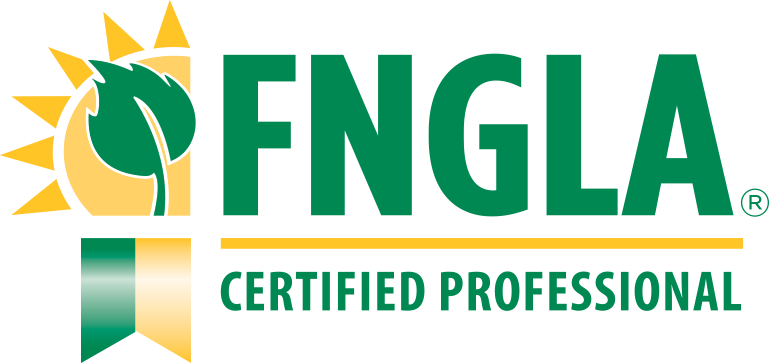
by Sheila Dunning | Dec 3, 2021
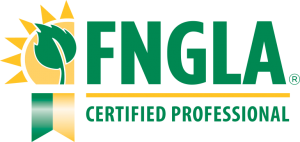 No previous experience or accreditation it required to be a landscaper in the state of Florida. So when homeowners are searching for service providers, it is important that they question potential companies about their skills. One good measure is completion of voluntary certifications such as the Florida Nursery, Growers and Landscape Association (FNGLA) Certified Horticulture Professional (FCHP). The FCHP program has been the industry’s standard for measuring horticulture and landscape knowledge since 1984. The training is also useful for property managers, homeowner associations, retail garden center employees, or anyone that wants to know more about Florida’s plants and their care.
No previous experience or accreditation it required to be a landscaper in the state of Florida. So when homeowners are searching for service providers, it is important that they question potential companies about their skills. One good measure is completion of voluntary certifications such as the Florida Nursery, Growers and Landscape Association (FNGLA) Certified Horticulture Professional (FCHP). The FCHP program has been the industry’s standard for measuring horticulture and landscape knowledge since 1984. The training is also useful for property managers, homeowner associations, retail garden center employees, or anyone that wants to know more about Florida’s plants and their care.
Plants are complex and variable living things that range from microscopic to the largest of living organisms. With steady population growth in the state of Florida, environmental damage risks created by the use of improper products and practices has continually risen. State and federal natural resource protection agencies have restricted certain horticultural practices including fertilizer and pesticide application. It takes scientific knowledge to properly maintain lawns and landscapes, not just a “green thumb” in order to keep plants healthy while reducing contamination to the soil, air and water that we all need.
The Florida Certified Horticulture Professional training covers 16 areas, including identification, fertilization, irrigation, pest management, safety and business practices. Lecture and hands-on activities are utilized at each session. The 60-hour course will enhance anyone’s knowledge and will provide the basis for professionals to deliver a skilled service to clientele. The course is available in-person or virtually via Zoom.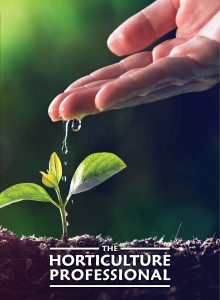
If you are a green industry worker or a concerned citizen interested in attending a FCHP preparatory course, there is an opportunity coming up in Crestview. Beginning Thursday, January 6, 2022 and continuing for 8 weeks to February 24, 2022, the Okaloosa County Extension office will be providing training for $185, which included the newest hard copy manual and plant identification book. Contact Sheila Dunning, 850-689-5850, sdunning@ufl.edu for more information.
For more details and to register go to: https://www.eventbrite.com/e/florida-certified-horticulture-professional-fchp-training-tickets-215748017127
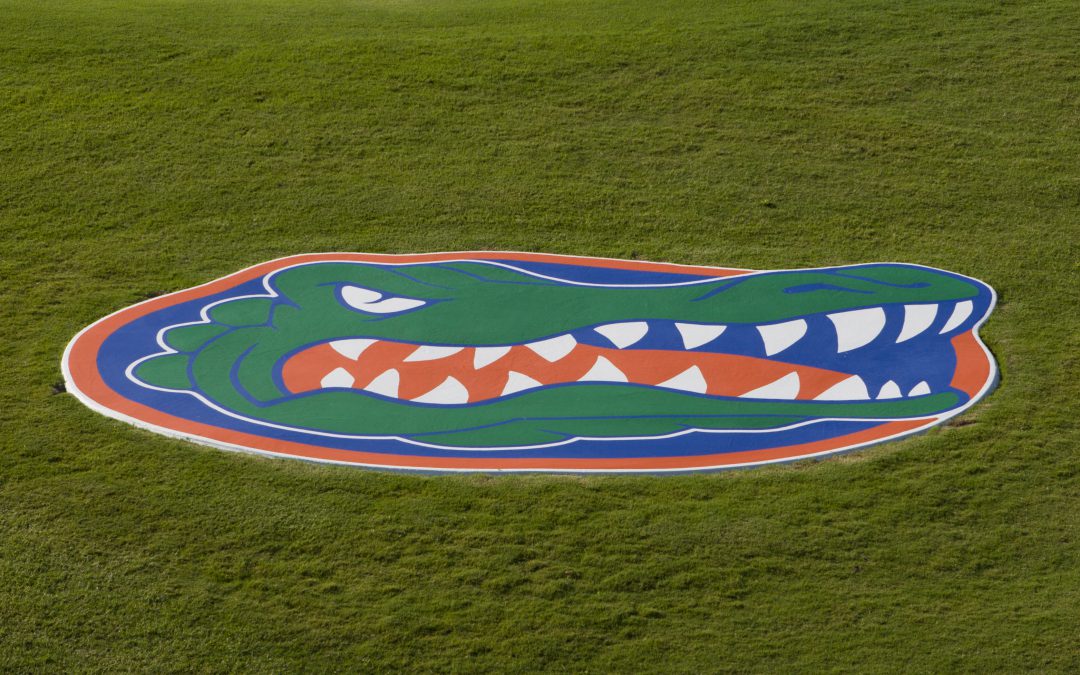
by Julie McConnell | Jun 7, 2021
We’re back! After the COVID-19 hiatus, the Gulf Coast Turfgrass Field Day & Expo returns to the normal third Wednesday in June time slot.
Join us June 16, 2021 for a COVID-19 friendly, in-person field day. Due to COVID-19 protocols, ALL ATTENDEES MUST PREREGISTER before June 15th. There will be NO on-site registration, so get your ticket now!
ATTENDEE REGISTRATION: Choose ONLY one of the four ticket options:
- Field Tour, Scouting Insects, Spill Drills
- Field Tour, Scouting Insects, Natural Pesticides
- Field Tour, Spill Drills, Natural Pesticides
- Field Tour ONLY
MORNING RESEARCH FORUM – Everybody is ready to get back to “normal” and so are the University of Florida scientists who are coming to the Turfgrass Field Day in full force – even a few you’ve likely never met in person! Change abounds and this year’s field day is no different. The line-up this year will have four focus areas and will allow greater time for interaction with the researchers.
Future Urban Landscapes – water quality and quantity concerns are major drivers leading to changes in what future landscapes will look like.
- Agustin Boeri, Graduate Research Assistant
- A.J. Reisinger, UF Soil and Water Scientist
- Mark Lusk, UF Soil and Water Scientist
- Michael Dukes, UF Irrigation Specialist
- Adam Dale, UF Turf Entomologist
- J. Bryan Unruh, UF Turf Specialist
Pest Management – pests continue to create challenges when managing turf.
- Billy Crow, UF Turf Nematologist
- Adam Dale, UF Turf Entomologist
- Phil Harmon, UF Turf Pathologist
- Pawel Petelwicz, UF Turf Weed Scientist
Turfgrass Breeding & Cultivar Development – tremendous effort is underway to bring improved turfgrasses (color, quality, reduced water and nutrition) to the market.
- Kevin Kenworthy, UF Turf Breeder
- J. Bryan Unruh, UF Turf Specialist
- Chase McKeithen, UF Turf Biological Scientist
Cultural Management – research on how to better manage turf.
- Jason Kruse, UF Athletic Turf Specialist
- Marco Schiavon, UF Turf Specialist
- J. Bryan Unruh, UF Turf Specialist
VENDOR EXPO – This year’s vendor expo will be an open air “tail-gate” style event to allow for social distancing and COVID-19 safety protocols. Vendors will be stationed in the grassy areas around the perimeter of the turfgrass research plots. Attendees will have opportunity to visit before, during, and after the research tours.
A limited number of tables and chairs will be available for the vendors. Vendors should plan to bring a pop-up tent if you have one!
Please note: To see all ticketing options please do the following: Upon entering Eventbrite site using link below, click “Tickets” link and then “I want to get tickets” “As an individual” to see all ticketing options.
LUNCH – BBQ Buffet lunches aren’t the most COVID friendly so we are changing up the menu and the venue a bit. Box lunches will be provided out on the research plots. Grab your lunch and find a shade tree, huddle under a vendor tent, or head back to your vehicle for a bit (you may want to turn your A/C on to cool off!).
AFTERNOON PESTICIDE LICENSE CONTINUING EDUCATION – Three sessions will be offered this year. All three classes will be available from ~ 12-1 and 1-2; each class will repeat with different audience so attendees can choose to get 2 different core or 1 category and 1 core CEU.
Scouting for Insects in the Landscape. This session will focus on identification of signs and symptoms of common insect pests in landscape plants. 1 Category CEU O&T, LCLM, LLO, Comm L&O will be requested for this session.
Spill Drills. Do you know what to do in an emergency? This session will cover multiple spill scenarios and what action needs to be taken to prevent injury and environmental harm. 1 Core CEU will be requested for this session.
Natural Pesticides for the Landscape. Many property owners are interested in using “natural” or low-risk pesticides but are they really effective? This session will discuss pesticide products that are labeled as natural and/or organic. 1 Core CEU will be requested for this session.
REGISTER NOW: https://2021gcturfgrassexpo.eventbrite.com

by Sheila Dunning | Apr 27, 2020
Turf pros, you have fought for years to try to get enough downtime on your sports turf to really work on making big improvements. Now, with school and city leagues cancelled, is the perfect time. The grass has
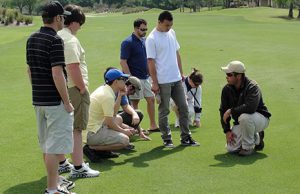
https://plantscience.ifas.ufl.edu/turfgrass-science/
greened up and is needing mowing. The soil temperatures are up. We have gotten a decent rain with more predicted. So, plan to make some of those much-needed improvements in May.
If you haven’t submitted soil samples, start with getting that baseline information. All the labs are open and working, including UF. Sampling kits and instructions are available at: https://soilslab.ifas.ufl.edu/ESTL%20Tests.asp.
Get out there and fix all the irrigation system imperfections. Knowing the water output and uniformity can make all the difference in the turf appearance and response to fertilizers, not to mention reducing disease pressure. Make sure you have head-to-head coverage, not the “almost” head-to-head coverage that cheats a few feet here and there. Calibrate each zone to determine how much time it takes to deliver ¾ inch of water. Watch this video for more information: https://www.youtube.com/watch?v=W_wn-hwLNtg
Take this time to accurately measure the areas that will need fertilizing and calibrate your spreader to you and the product. Set the application schedule for the rest of the year. Accomplishing this now when you’re not so pressed for time will pay off. Remember with rotary spreaders, fertilizer distribution is not uniform. More granules fall in the middle of the pass than along the outer edges. To achieve uniformity, check that the tire is just inside the track from the previous pass and that the granules are reaching the previous track. Additionally, apply in two directions.
How about reducing compaction and improving the overall soil conditions? That’s the one project you’ve been wanting to do for many seasons. Physical penetration of the soil improves air, water, and nutrient movement within the root zone. This is especially important for high traffic areas. A hollow tine, or core, aerator pulls soil cores from a 2-6 -inch depth. Cores can be removed or dried on the surface and reincorporated using a drag mat. If thatch is an issue, consider vertical mowing to cut into the turf runners and loosen the dead tissue layer. Then, rake, rake and rake! The grass will look rough for a while during the recovery but will be much healthier in the long run.
When you get your soil test results back, they will identify nutrient deficiencies and recommend lime and fertilizer for the year. Lime should only be applied in accordance with the recommendations on soil test results. Over-application can take years to correct. Split applications of the annual required rate will allow for more adjustment. Nitrogen influences color and many growth factors. Application rate recommendations are based on research-driven requirements for each grass type. However, nitrogen comes in quick-release and/or slow-release. Quick release products are water soluble and cause a turf response in a week or less but can evaporate or burn. Application should always be followed by ¼ inch of irrigation to get the most benefit. Slow release products are water insoluble and provide a gradual, consistent turf response over a 3-10-week period. They require warm, moist soil with microbes in order to release nitrogen. Most of the available fertilizers will have a combination of both quick and slow release components. That way there is an immediate green up with long lasting color. Bermudagrass needs 0.5-1 pound of soluble N/ 1,000 sq. ft. to get going in the spring.
You’ve been saying, “We need to get some of these big tasks done, but just can’t find the time when no one is on the field.” Here’s your chance.
by Sheila Dunning | Jul 12, 2018
As of January 2015 the labels on fertilizer bags have changed. Florida Rule 5E-1.003 required fertilizer manufacturers to modify their package recommendations and wording.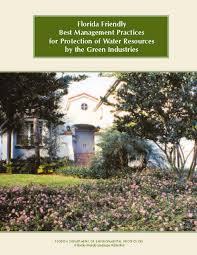
“Specialty fertilizers” was one of the more significant changes. This included packages that weigh 49 pounds or less and are labeled for home (residential) lawn use. The new labeling requirement for fertilizers labeled for use on urban lawns included that these products must be no phosphate or low phosphate. “No phosphate” fertilizers will be expressed as zero in the guaranteed analysis. “Low phosphate” fertilizers typically have 2% when labeled for residential lawns. Additionally, the recommended application rate must not exceed 0.25 lbs. P2O5 / 1,000 square feet per application and cannot exceed 0.50 lbs. P2O5 / 1,000 square feet per year. The only exception is “starter fertilizers”, which is a fertilizer formulated for a one-time application at planting or near that time to encourage root growth. A starter fertilizer can recommend a one-time application rate of 1.0 lb. of P2O5 / 1,000 square feet.
The Label is the Law
Application rates cannot be exceeded and the site must be on the label. The “site” refers to the specific grass area that the application is intended for. So, for fertilizer packaging under Rule SE-1.003 there a few definitions you need to understand:
- “Urban Turf” or “Lawns” means non-agricultural land planted in closely mowed, managed grasses except golf courses, parks and athletic fields.
- “New Urban Turf” means residential lawns established less than 12 months.
- “Actively Growing Turf” means turf that needs mowing at least once every two weeks to maintain the grass blade height according to the UF/IFAS recommendation.
- “Established Urban Turf” means residential lawns older than 12 months.
In addition to restrictions on phosphate, the Urban Turf Rule restricts the use of nitrogen. The amount that can be applied at once, as well as, annually and the seasonal application timing are defined based on the different regions of Florida. Local ordinances may be even more restrictive than the fertilizer label.
The following language must appear on all fertilizers sold at retail:
- “Apply only to actively growing turf”.
- “Do not apply near water, storm drains or drainage ditches”.
- “Do not apply if heavy rain is expected”.
- Apply this product only to your lawn and sweep any product that lands in the driveway, sidewalk or street back onto your lawn.
Finally, the labeling requirements for fertilizers that come in 50 pound bags or larger include that the directions for use cannot exceed rates recommended in the document entitled “Florida Friendly Best Management Practices for Protection of Water Resources by the Green Industries” (GI-BMP). The GI-BMP restricts nitrogen applications to less than what the label states. If the slow-release component of the overall nitrogen percentages is 30% or greater, the product can be applied at 1.0 lb. of N / 1,000 sq. ft. If it is less than 30%, then the rate is only 0.50 lb. N / 1,000 sq. ft.
The next time you are shopping for fertilizer, take the time to read the bag. Know that you are applying it correctly and legally.
By the way, if you are being compensated for applying fertilizer, FDACS requires a Limited Urban Commercial Fertilizer application certification with a pre-requisite of GI-BMP training.
Upcoming classes in Northwest Florida
Statewide GI-BMP classes
by Blake Thaxton | Mar 24, 2016
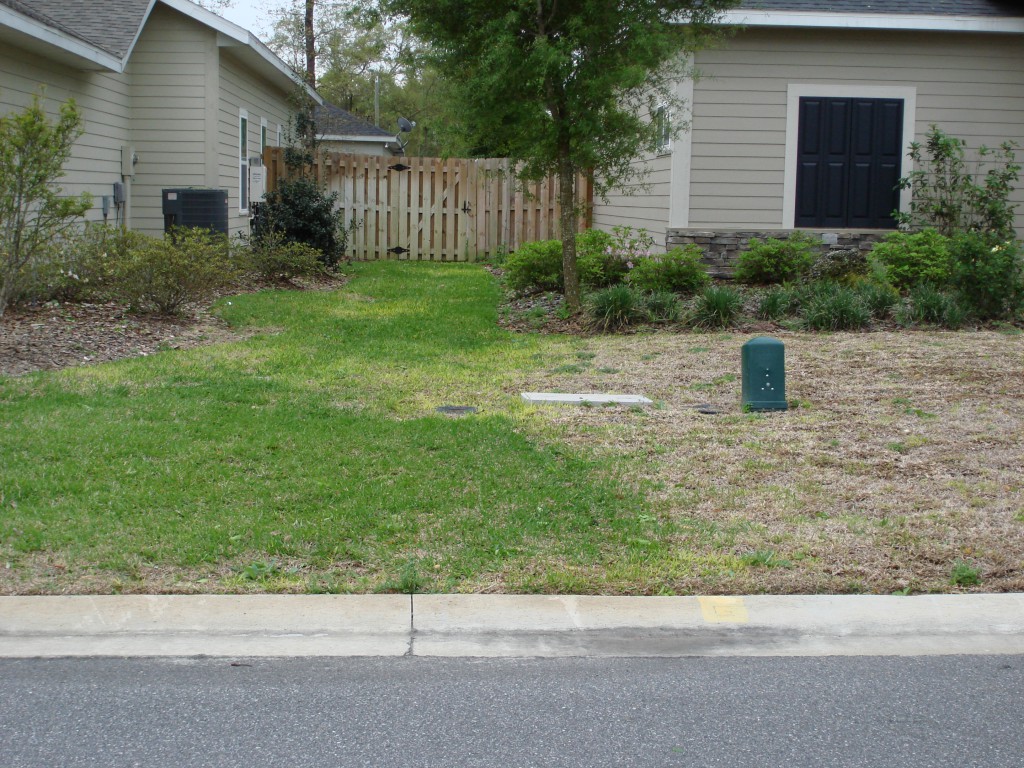
Winter kill. Photo Credit: J. Bryan Unruh
Author: J. Bryan Unruh, Ph.D. – Extension Turf Specialist
Spring has sprung! With that comes the urge to ramp up spring landscaping projects – planting a garden; replenishing the mulch in the beds; planting summer annuals for color; preventing that nasty crabgrass from germinating; and fertilizing the lawn. STOP! WAIT! TIMEOUT!
“Weed-and-Feed” products are commonly marketed in most garden centers and box stores. However, the use of weed-and-feed products should largely be avoided in Northwest Florida. Here’s why. In northwest Florida, crabgrass typically germinates around March 1st – give or take a couple of weeks based on spring conditions (warmer = earlier) or whether you reside along the coast or in the northern reaches of your county. Consequently, with March almost behind us, we are beyond the window of opportunity to control crabgrass before it germinates. Crabgrass control measures now must rely on postemergence (after the weed germinates) options. For all of our turfgrasses, except Bahiagrass and St. Augustinegrass, a number of options are available. Refer to https://edis.ifas.ufl.edu/EP141 for more information. There are no postemergence crabgrass herbicides registered for use on St. Augustinegrass!
The “feed” side of “weed-and-feed” provides plant nutrition – through the application of fertilizer. However, UF/IFAS does not recommend lawn fertilization prior to April 15th in northwest Florida. There are a couple of reasons why UF/IFAS doesn’t recommend early spring fertilization. First, it is very common for portions of northwest Florida to experience heavy frosts through March and into the first week of April. We desire for the turf to remain “at rest” until after the first week of April. Fertilizing prior to April 15th nearly guarantees that the lawn will be awakened making it prone to severe damage should a late spring frost occur (Figure 1). Second, UF/IFAS scientists hypothesize that the turfgrass root system (the part you can’t see) lags behind the shoot system (the part you can see). When fertilizer granules are applied to the lawn, the granules dissolve and the nutrients become part of the soil solution (soil water + dissolved substances). Liquid applied fertilizers go directly into the soil solution. If the root system is not ready to absorb the nutrients, the nutrients are likely to leach below the rootzone and can potentially move into the groundwater as a pollutant. UF/IFAS research conducted near Pensacola and south of Gainesville conclusively showed that fertilizer applied around March 1st had elevated nutrient leaching. Conversely, when fertilizer is properly applied to a healthy lawn, the turf will assimilate all the applied nutrients and not cause environmental problems.
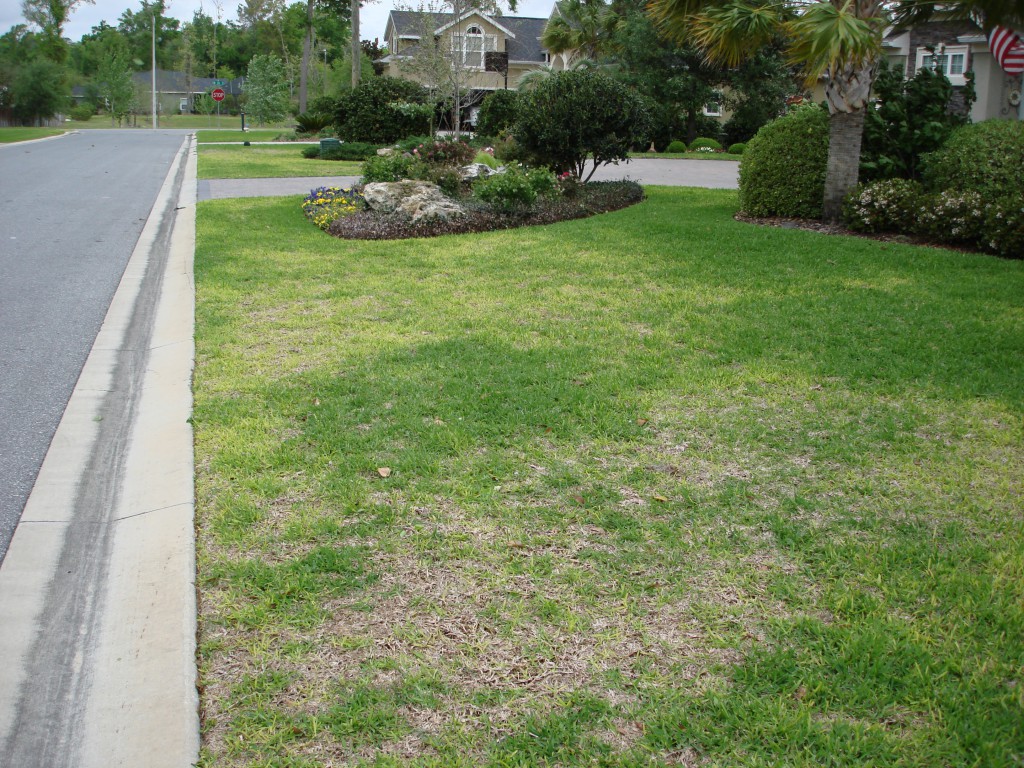
Patchy winter kill. Photo Credit: J. Bryan Unruh
What about “weed-and-feed” products for broadleaf weeds such as dollarweed (https://edis.ifas.ufl.edu/EP389) or Virginia buttonweed (https://edis.ifas.ufl.edu/EP386)? Generally, these weeds do not inhabit the entire property – they appear only in patches scattered throughout the lawn. Why then, would you apply chemicals to an entire lawn when only a small area needs to be treated? The answer is simple – you shouldn’t. Under this scenario, it would be best to use “Ready-to-Use” products or make a mix from a concentrated product and deliver through a pump-up type sprayer.
Bottomline – go ahead a start your spring gardening. Plant your garden. Refresh the plant beds. Plant those annuals and perennials to give you the color you want. If you haven’t fertilized yet – great. Wait until mid-April or later. If you have already fertilized and your lawn is green – hope that we don’t get a late-season frost!

 No previous experience or accreditation it required to be a landscaper in the state of Florida. So when homeowners are searching for service providers, it is important that they question potential companies about their skills. One good measure is completion of voluntary certifications such as the Florida Nursery, Growers and Landscape Association (FNGLA) Certified Horticulture Professional (FCHP). The FCHP program has been the industry’s standard for measuring horticulture and landscape knowledge since 1984. The training is also useful for property managers, homeowner associations, retail garden center employees, or anyone that wants to know more about Florida’s plants and their care.
No previous experience or accreditation it required to be a landscaper in the state of Florida. So when homeowners are searching for service providers, it is important that they question potential companies about their skills. One good measure is completion of voluntary certifications such as the Florida Nursery, Growers and Landscape Association (FNGLA) Certified Horticulture Professional (FCHP). The FCHP program has been the industry’s standard for measuring horticulture and landscape knowledge since 1984. The training is also useful for property managers, homeowner associations, retail garden center employees, or anyone that wants to know more about Florida’s plants and their care.




